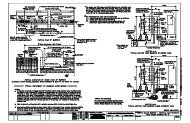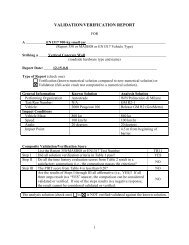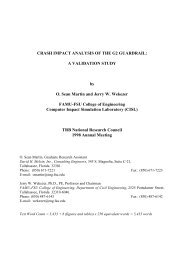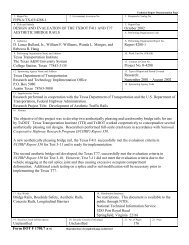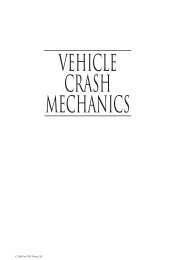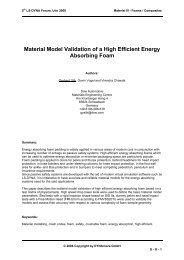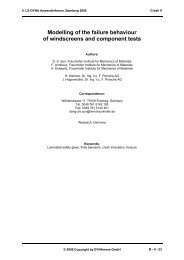Vehicle Crashworthiness and Occupant Protection - Chapter 3
Vehicle Crashworthiness and Occupant Protection - Chapter 3
Vehicle Crashworthiness and Occupant Protection - Chapter 3
You also want an ePaper? Increase the reach of your titles
YUMPU automatically turns print PDFs into web optimized ePapers that Google loves.
Finite Element Analytical Techniques<br />
<strong>and</strong> Applications to Structural Design<br />
with shell elements, node-to-segment contact force transmissions, <strong>and</strong> plane<br />
stress elasto-plasticity. Since these are still the basic algorithms used in today’s<br />
analysis environment, it is not surprising that as early as 1973, very good analytical<br />
results were obtained on vehicle substructures. The continuum approach, however,<br />
remained mainly in the province of research, since the goal of full-vehicle simulation<br />
could not be achieved with sufficient accuracy due to the limited number of shell<br />
elements that could be h<strong>and</strong>led by state-of-the-art computers before the mid-<br />
1980s. The resulting coarse meshes did not allow a representation of the global<br />
buckling modes in a full-vehicle model. Due to the high degree of interaction<br />
between the different panels of an automobile structure, it is necessary to consider<br />
the full vehicle in a single model to predict the energy absorption of the individual<br />
parts during a crash. The inability to fulfill this requirement brought the continuum<br />
approach <strong>and</strong> thus, the finite element approach, to automotive crash simulations<br />
to a st<strong>and</strong>still in the late 1970s <strong>and</strong> early 1980s.<br />
The second period of development began in 1985 <strong>and</strong> continues to the present. It<br />
can be characterized as a period of rapid growth in both explicit finite element<br />
technology development <strong>and</strong> applications to progressively more complex vehicle<br />
structures. The breakthrough of finite element methods in this field <strong>and</strong> their<br />
consequent implementation in the design process of vehicles happened in the<br />
mid-1980s [14-17]. During these years, vectorized supercomputers were introduced<br />
to the industry, allowing explicit finite element technology to establish itself as<br />
the leading numerical technique for crashworthiness calculations of vehicle<br />
structures. These few crucial years paved the way for the rapid <strong>and</strong> dramatic<br />
evolution in the following decade, when analytical tools evolved from the research<br />
environment to an integrated <strong>and</strong> essential part of the vehicle design process.<br />
Although similar processes occurred roughly simultaneously in Japan [18], the<br />
United States [19], <strong>and</strong> Europe [20], the first writing about application of explicit<br />
FE technology to crashworthiness of actual vehicle structure was published by<br />
ESI in 1985 [21]. ESI modeled the front vehicle structure of a VW POLO impact<br />
into a rigid barrier, from an initial velocity of 13.4 m/s. The FE model simulated the<br />
structure by 2,272 shell <strong>and</strong> 106 beam elements. An elastic-plastic constitutive<br />
model with strain hardening was used to describe the sheet metal behavior. The<br />
analysis provided vehicle kinematics <strong>and</strong> barrier force-time pulse. Subsequent to<br />
this simulation, automotive manufacturers have attempted many crashworthiness<br />
calculations. This chapter focuses on the efforts of the German automotive<br />
industry to develop an analytical capability, primarily due to one of the authors’<br />
involvement in these developments.<br />
The genesis of the VW POLO model can be traced back to the<br />
Forschungsgemeinschaft-Automobiltechnik (FAT) committee of Germany. The<br />
Page 113



